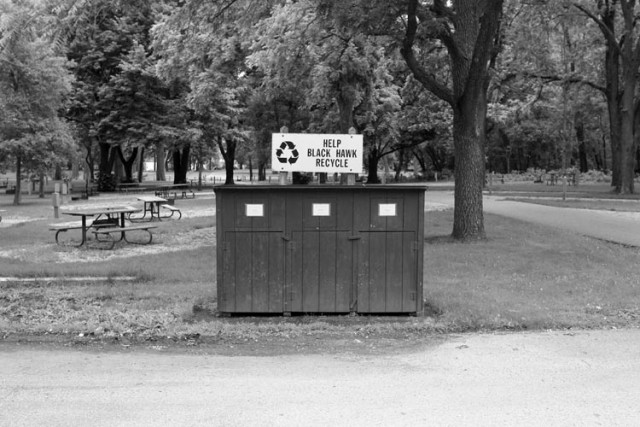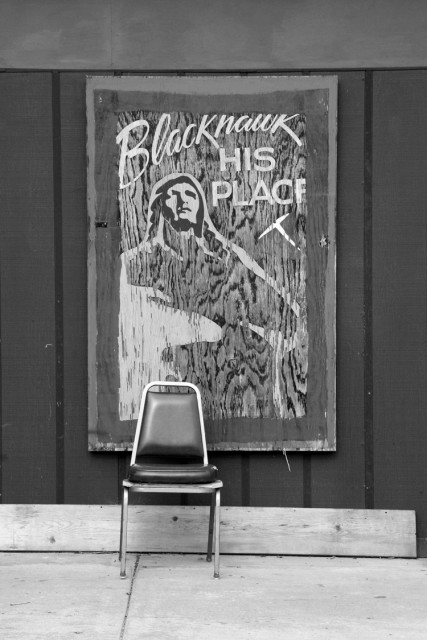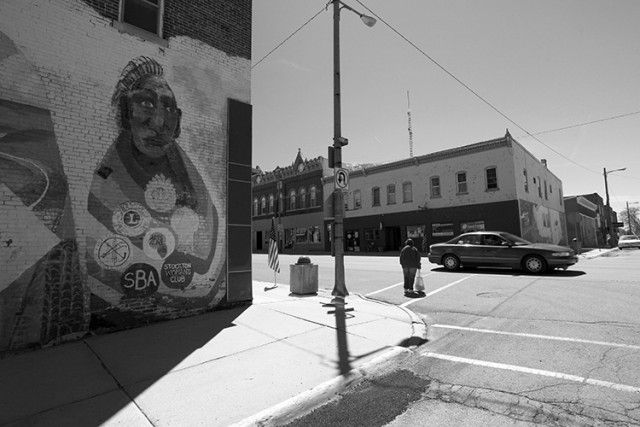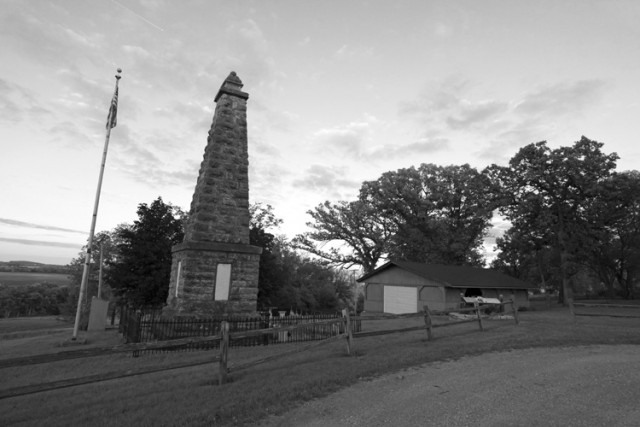Excerpted from the introduction by Nicholas A. Brown and Sarah Kanouse
Download PDF
RE-COLLECTING, RE-ASSEMBLING, AND RE-ASSOCIATING BLACK HAWK
The meanings of landscape, whether historical or for the future, are never simply there, inherent and voluble. Instead, they are made to speak, invited to show themselves, and that invitation is the process of practicing landscape which always places landscape in a present moment. This presentation is a crucial one and a political one, for it disrupts accounts of landscape which seek to ground certain claims and identities in a self-evident earth. Landscapes are always perceived in a particular way at a particular time. They are mobilized, and in that mobilization may become productive: productive in relation to a past or to a future, but that relation is always drawn with regard to a present.
– Mark Dorrian and Gillian Rose, Deterritorialisations . . . Revisioning Landscapes and Politics
Re-Collecting Black Hawk is an extended image-text essay exploring the cultural and political landscapes of the Midwest. It brings together roughly 170 photographs of historical markers and monuments, organizations, sports teams, consumer products, businesses, parks, subdivisions, and other places that reference the nineteenth-century Sauk leader Makataimeshekiakiak. These photographs are arranged geographically and organized into chapters by state (Iowa, Illinois, and Wisconsin). Each image is paired with an appropriated text drawn from sources as wide ranging as press releases and scholarly histories, government reports and advertisements, and poetry and recipes published in tribal newspapers. Interwoven throughout are contributions by and interviews with activists, scholars, and tribal officials, who, in some cases, reflect on the image-text strategy and, in other cases, ground it in specific, current struggles around decolonization, self-determination, and cultural revitalization.

On the most basic level, Re-Collecting Black Hawk is both a call and an attempt to practice landscape differently. It proceeds by staging a series of encounters between image and text, each with different implications in the realm of political imagination. The purpose of staging these encounters is to call attention to relationships or the lack thereof, as the case may be. These juxtapositions highlight disconnect—or what Elizabeth Povinelli might call “dead dialectics”—but also, in a more speculative manner, propose living dialectics that are grounded in and accountable to collective visions of justice. The encounters operate on multiple levels, suggesting a range of possible relations within pairs and also between pairings. Together they produce a deeper map of the territory, which necessarily entails the “decolonization of our spatial imaginations.” The encounters represent, therefore, a modest and regionally specific contribution to the larger project, described by Jodi Byrd, of “imagining an entirely different map and understanding of territory and space: a map constituted by over 565 sovereign Indigenous nations, with their own borders and boundaries, that transgress what has been naturalized as contiguous territory divided into 48 states.” The book’s title suggests this approach and holds a double meaning. In the most literal sense, it connotes the remembering of something past. The hyphen, however, hints at another, more active meaning. To re-collect is to gather again or to collect anew in the present. Or, following Bruno Latour, to re-collect is to reassemble Black Hawk in a manner that accounts for the disconnection between past and present, absence and presence. With this in mind, the small sign posted above a row of trashcans at Black Hawk State Park in Lake View, Iowa, could refer to more than just an environmentally responsible way to handle glass, plastic, and metal. “Help Black Hawk Recycle,” appeals the sign. Putting aside for a moment its more obvious meaning, the sign can also be read as an invitation—to campers, fishermen, birdwatchers, or anyone else who happens upon his eponymous park—to help Black Hawk re-collect, re-assemble, and re-associate his name, image, and legacy.
Re-Collecting Black Hawk is more about the present, less about the past. The history of the Black Hawk War is important. This book, however, is not primarily about the war, nor is it about the person for whom the war is named. Rather, it is about the various and conflicting ways the history of that war and the memory of that person function in the present. It is an argument for the importance not only of remembering and forgetting—present tense practices—in shaping both history and the landscape but also recognizing the power geometries within which these contemporary mobilizations of the past are situated. In an encounter between existing and evolving political temporalities, settler practices of commemoration—depicted through photographs—allude to history and our colonial past. “That happened there,” the monument declares. In contrast, the texts speak to our colonial present. They refuse to be contained by the past tense. “This is happening here,” insist activists blockading the route of an oil pipeline through sovereign tribal lands. As opposed to confronting a monument in the landscape or happening upon a provocative activist news release, encountering the monument and the news item in close proximity encourages us to reflect on possible relationships. Or, if nothing else, it calls attention to our unwillingness or failure to do so.

If Re-Collecting Black Hawk is more about the present, less about the past, it is also more about presence, less about absence. Taking present presence as its baseline, and thus establishing certain horizons of possibility, this book considers the unevenness of presence, the legibility of presence, and the potential for just and sustainable co-presence. The materiality of the built environment—business signs, historical markers, and other ephemera—is contrasted with the corporeality of Indigenous sovereignty and the everyday life circumstances of Indigenous peoples living throughout the region. In an encounter between existing and evolving political geographies, a settler landscape of commemoration—evoked through photographs—is juxtaposed with an Indigenous landscape of resilience or “survivance”—evoked through texts. Despite the really real (and really ongoing) processes of dispossession and colonization in the region, there remain robust and evolving Indigenous political geographies that have never been extinguished. Eschewing the task of recuperating Indigenous voices, restoring aboriginal presence, or giving the gift of liberal multiculturalism, Re-Collecting Black Hawk instead calls attention to the polyvalent voices and presences that always already constitute the Midwestern landscape, as well as the traditional and emergent practices of “critical individual and collective self-recognition” that continue to reshape our understandings of the region. “Black Hawk’s story ultimately is not about disappearance but survival,” argues Mark Rifkin, as it “draws attention to traditional (regional) social formations alternately ignored and assaulted by the United States and insists on the meaninglessness of a rhetoric of Indian assent in the absence of a substantive reckoning with the self-understandings and lived topographies of native peoples.”
The act of re-collecting, re-assembling, and re-associating can be understood as a methodology of sorts—a means without ends that is aligned, conceptually and practically, with ongoing processes of decolonization. As outward manifestations of this methodology, the staged encounters found throughout this book function partly as a way of interrogating the denial of relationships and asking critical questions about the continuity of colonial logics. A particular pairing of image and text may elicit the question, How is it possible to commemorate the Battle of Stillman’s Run without reflecting on the contemporary politics of repatriation in Illinois? Another pairing might provoke the reader to ask, How do present-day tensions around blood quantum and citizenship in Tama, Iowa, inflect our historical understanding of the shifting intertribal alliances at the time of the Battle of Wisconsin Heights? In contrast, other juxtapositions may prompt more general questions or meta-level reflection. What allows denial to endure? And whose interests does disconnection serve? In the words of Sandy Grande, “What is gained from the proliferation of essentialist portrayals of whitestream domination and Indian subjugation?” Alternately, what are the consequences of remaining trapped in a “dialectics of genocide”? Encountering these encounters, and the range of new relationships and horizons of possibility they suggest, readers may ultimately ask, What is to be done? This vital question reflects a growing desire to move beyond the “economy of equivalence” and to grapple in a substantive manner with the political consequences of social difference. Instead of simply asking about the function of commemoration, we begin to speculate about how we might commemorate or mobilize the past differently, in a manner that promotes justice and prefigures habitable worlds.
RE-IMAGING BLACK HAWK
There is never a single approach to something remembered. The remembered is not like a terminus at the end of a line. Numerous approaches or stimuli converge upon it and lead to it. Words, comparisons, signs need to create a context for a printed photograph in a comparable way; that is to say, they must mark and leave open diverse approaches. A radial system has to be constructed around the photo- graph so that it may be seen in terms which are simultaneously personal, political, economic, dramatic, everyday, and historic.
– John Berger, “Uses of Photography”
The photo-essay that forms the core of Re-Collecting Black Hawk revolves around the complex relations between image and text, past and present, presence and absence, and colonialism and resistance that have long been co-implicated in the modes of photographic representation. Edward Curtis’s iconic images of unsmiling nineteenth-century Indians continue to echo in contemporary stereotypes of“authentic” Indigenous people as noble, stoic, and doomed, if not already extinct. But the ideological work of photography—and what Raymond Williams terms the “structures of feeling” it supports—operates not just at the level of image but also of medium.

While its indexical relationship to reality has made the photograph a prized documentary form, photography itself is suffused with absence. What is captured photographically can be forever revisited but is understood to be gone. Roland Barthes famously claimed that the photograph always speaks of death because it eternally presents a past state of being—the image is “here now,” in a material sense, but also, inescapably, a record of a “having been.” The eternal past of Curtis’s portraits is not just a function of age, lighting, printing, subjects, and staging; the photographs reinforce in their very temporal structure cultural assumptions about the essential, if regrettable, pastness of Native Americans. In addition, photographs decontextualize as well as de-temporalize. Wrenched from context, images become scattered and fragmentary observations, deprived of the meanings that motivated them. Early portraits of Native Americans establish an aura of “authentic Indianness” because the specific significance of items of dress, dwellings, and activities depicted within them are unclear and therefore removed from the flow of history and cultural reinvention. As John Berger wrote, photographs “offer appearances—with all the credibility and gravity we normally lend to appearances—prised away from their meaning. Meaning is the result of understanding functions.”
The widespread practice of using Black Hawk’s mystique to name parks, decorate car washes, or anoint a new subdivision effects the same abstraction. Complexity is flattened into icon. Even more responsible settler practices—like consulting with tribes before erecting historical monuments—must radically simplify, first by rendering into narrative, then by shortening that narrative to fit on a sign. Makataimeshekiakiak, a human being with all the contradictions and complexity that entails, becomes literally dimensionless—a flat image printed on a sign or invoked through Roman letters spelling the English translation of his name. Far from summoning his enduring presence, the constant citation of Black Hawk underscores his absence and, by extension, the supposed pacification and removal of Native Americans. At the level of the image, our photographs of Black Hawk’s appropriated name and image perform the same conceptual violence that the original appropriations do to him. Each image is stripped of particularity and transformed into a signifier of settler colonialism. A geographically dispersed phenomenon is condensed into a book; a mom-and-pop business full of family memory and neighborhood lore is reduced to a four-by-six snapshot. A practice of appropriation that is no doubt in flux and someday may end is arrested at one moment of its development. Though this strategy could be read simply as turning the camera on the colonizer, it goes beyond mere documentation and can be seen as a hopeful gesture of decolonization. Our images operate in what Judith Butler calls the photograph’s “future anterior.” She writes, “The photograph relays less the present moment than the perspective, the pathos, of a time in which this will have been.” The fact that we chose to take the photographs in this book thinks forward to a time when businesses like Blackhawk River Runs will be renamed, not from pressures of political correctness but rather because today’s colonial relations will have been transformed.

Jodi Byrd calls for images that cause “people to acknowledge, to see, and to grapple with lived lives and the commensurable suffering” of colonial violence. Channeling Butler, she describes this as a process of “grieving,” as opposed to the sentimental lamentations of salvage portraiture, à la Edward Curtis. Given the structural limitation of photography to depict both the passage of time and social context (as Bertolt Brecht observed long ago), the image must be re-grounded in text. Responding to Berger’s charge in the epigraph to this section, this book creates a “radial system” for our loosely documentary images through texts, juxtapositions, and accumulations. If the Black Hawks represented in the photographs are floating signifiers or empty signs, as some have suggested, one of our goals is to reassociate and anchor them in the dynamic and evolving Indigenous political geographies represented by the texts. In short, we aim to connect absence with presence. Or, borrowing Gerald Vizenor’s language, one of our goals is to link “indians”—the “simulations of the tragic primitive,” which insinuate the “ruse of colonial dominance” and “an overseas enactment that has no referent to real native cultures or communities”—to “postindians,” “the storiers of an imagic presence.” Failing to make these connections, the empty signs and the “obvious simulations,” which proliferate under the banner of settler commemoration, will continue not only to resuscitate dead dialectics but also to cultivate a deadening dialectic. The disconnection, in other words, extends beyond our understanding of the historical and present-day lives of Native Americans to include future lives as well. The empty signs that circulate in the landscape diminish our capacity to imagine alternative futures. They inhibit the development of new forms of recognition and solidarity, reduce the possibility of “sustainable self-determination,” and prevent us from creating “a truly post-colonial relationship of peaceful co-existence.” Deeply invested in the future tense, Re-Collecting Black Hawk therefore scrutinizes the foreclosure of “futurity” in both the past and present.
Like the work of groundbreaking visual essayists such as Victor Burgin, Martha Rosler, and Allan Sekula, who used serial imagery and original and appropriated text to both de- and reconstruct images, Re-Collecting Black Hawk is a true image-text. This tradition runs counter to received conventions of the framed print as art object. Images are often appropriated (as in much of Rosler’s work) or are relatively unremarkable aesthetically, as in early photo-essays like Dan Graham’s Homes for America (1965), Ed Ruscha’s Every Building on the Sunset Strip (1966), or Allan Sekula’s Untitled Slide Sequence (1972). The use of a relatively amateur aesthetics, rather than “wow factor” verisimilitude, understands the photograph as an aspect of the material social process of ordinary culture, to use Raymond Williams’s terms. In this way, the image-text shows rather than tells, channeling Walter Benjamin’s literary essayism and Allan Pred’s performative geography. Neither illustrated essays nor captioned photographs, image-texts play up theinherent intertextuality of photographic interpretation to build, invent, or negotiate an environment in which they take on new, self-reflexive, and potentially decolonial meanings.
This visual essayist approach resonates with that thread of contemporary art where we locate this project: critical art practice. If, as the influential philosopher Jacques Rancière argues, the realm of the sensible—what can be seen, felt, and experienced—delimits the space of political imagination and action, then all art is inherently political, even when it is not overtly “about” politics. Critical art practice brings an awareness of art’s capacity to frame perception by asking probing questions about politicized content or by politicizing a topic by posing questions strategically. It is better understood as a method rather than a style or genre, a way of inquiring into social and political phenomena by making and assembling visual, spatial, or experiential notes about them. In contrast to what is typically described as activist artwork, a critical approach often explores “structures of feeling” rather than communicating a definitive position on a single issue. This is not to say that critical artists lack a position or pull their punches, though the current (relative) art world success of this work has prompted some soul searching. Yet as the skeptical practitioner Martha Rosler acknowledges, “art continues to have a mapping and even critical function in regard to geopolitical realities. Artists have the capacity to condense, anatomize, and represent symbolically complex social and historical processes.” Concerned in equal parts with social and political conditions “out there” in the world and with the complex ways concepts, practices, and images are dialectically bound up with them, critical artists pursue their investigations self-reflexively, recognizing that there is no outside position from which to critique or intervene. At their best, critical artworks are sites where maker and spectator both grapple with their expectations and find their sense of the world changed in the process. Critical art therefore asks much more of the viewer than passive aesthetic contemplation. It demands attention simultaneously to the ostensible content of the work, the methods by which it is presented, the shifting positions of producer and spectator, and the spaces of political and aesthetic possibility it opens up.

Influenced by the shift from modernism’s autonomous art object to Umberto Eco’s open work, or from Barthes’s readerly text to the writerly text, the forms of intellectual and political engagement prompted by critical art resonate with a broader struggle for cultural decolonization. The Transnational Decolonial Institute, a loose group of artists, critics, and scholars, recently formed with the aim of devising a properly intercultural and decolonial aesthetics that recognizes the centrality of colonialism to modernity. Their statement of purpose explains, “Within different genealogies of re-existence ‘artists’ have been questioning the role and the name that has been assigned to them. They are aware of the confinement that Euro-centered concepts of arts and aesthetics have imposed on them. . . . They are dwelling in the borders, sensing in the borders, doing in the borders, they have been the propellers of decolonial transmodern thinking and aesthetics.”
The methods and aesthetics of these projects may—indeed must—look different depending on the operative colonial contexts, but art can play a vital role in any case. Recognition of its unique capacities is implicit in notions such as “intellectual sovereignty,” “cultural sovereignty,” and “sovereign Native spatial discourse.” The significance of cultural production vis-à-vis sovereignty and self-determination is more explicit, for example, in the recently ratified Constitution of the White Earth Nation, coauthored by the Anishinaabe poet, novelist, and critic Gerald Vizenor. Chapter 3, article 5 of the Constitution reads: “The freedom of thought and conscience, academic, artistic irony, and literary expression, shall not be denied, violated or controverted by the government.” Those of us working with a Euro-American colonial heritage must consider not only how settlers can act in solidarity with Indigenous intellectual self-determination but also how settlers can decolonize our own cultural imagination. Recent examples of anticolonial aesthetics include Gaye Chan’s Waikiki: A History of Forgetting and Remembering, Drex Brooks’s Sweet Medicine, and Robert Adams’s Turning Back. Like Re-Collecting Black Hawk, these photographic books arise from the dense, fraught, and layered territory of history, memory, and cohabitation that is our colonial inheritance, implicating the reader in the labor of weaving together these fragments and conceptual disjunctions and leaving it up to us—readers, writers, image makers, Natives, and non-Natives—to make something like justice of it.